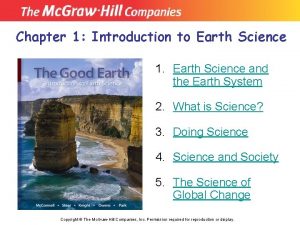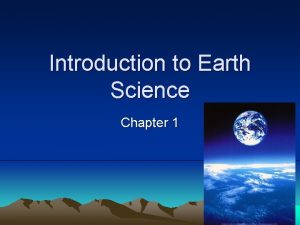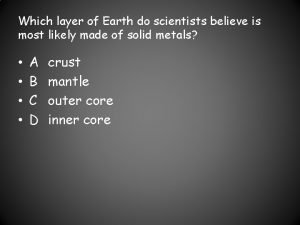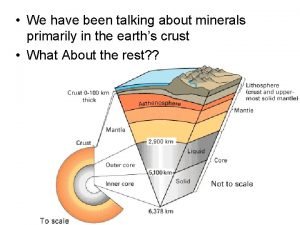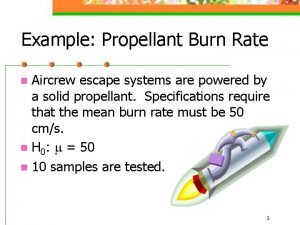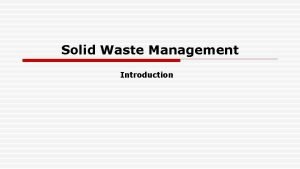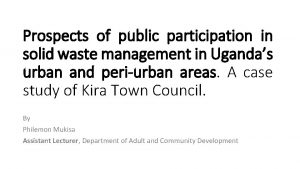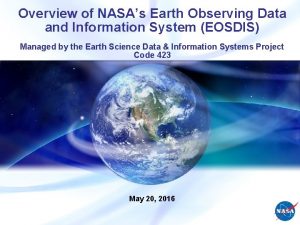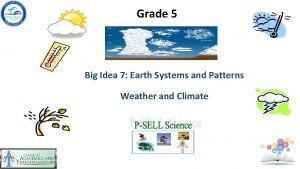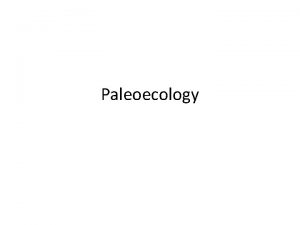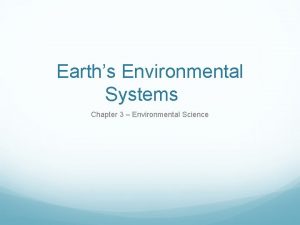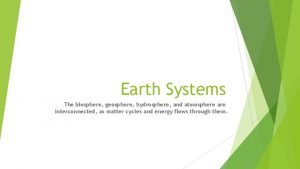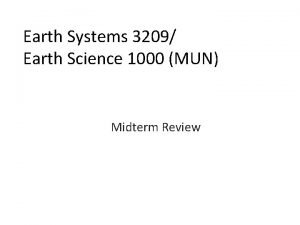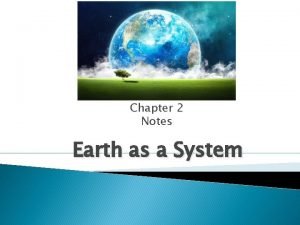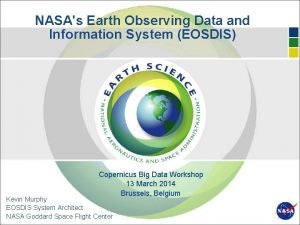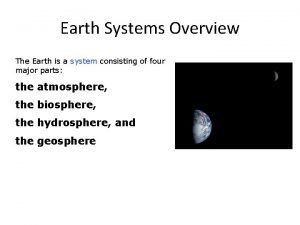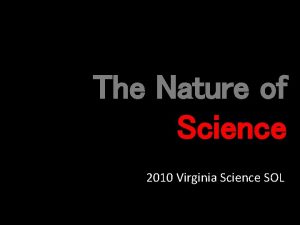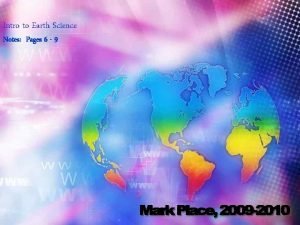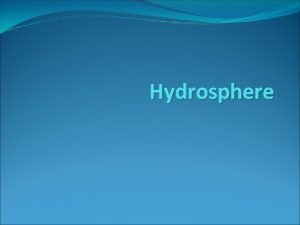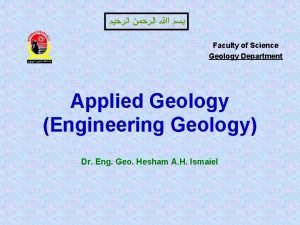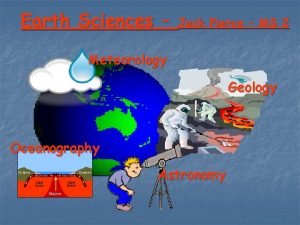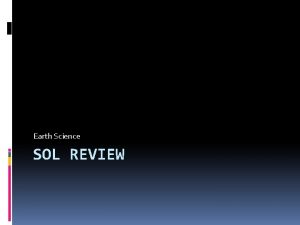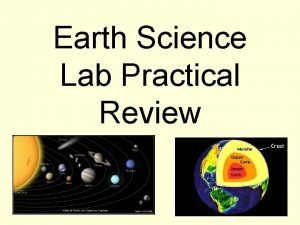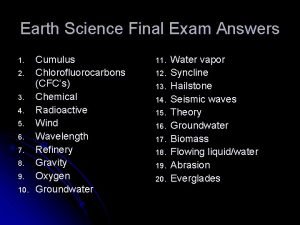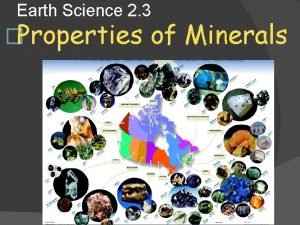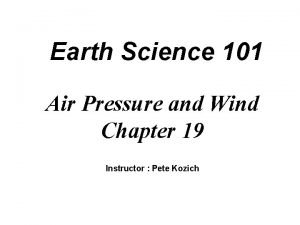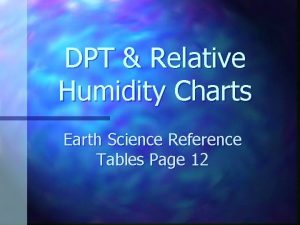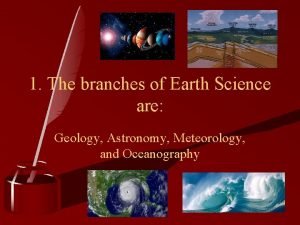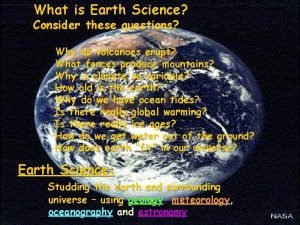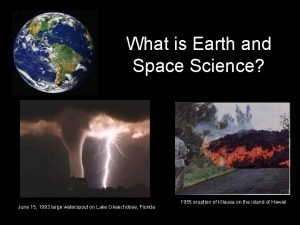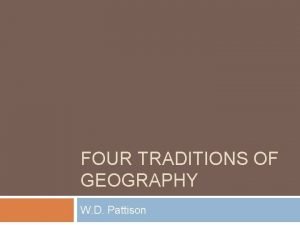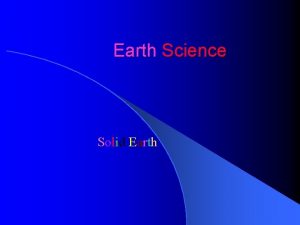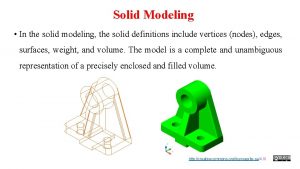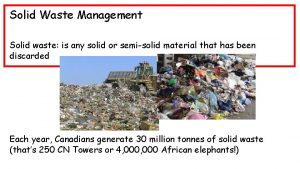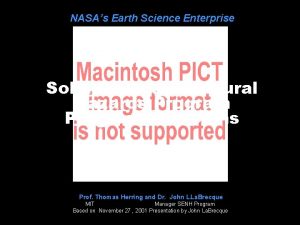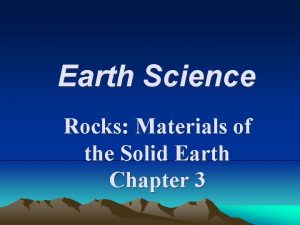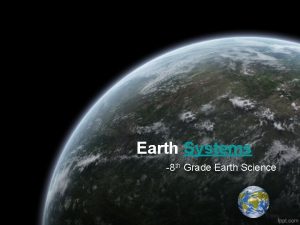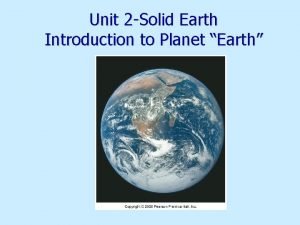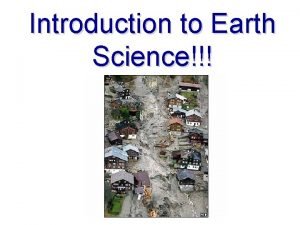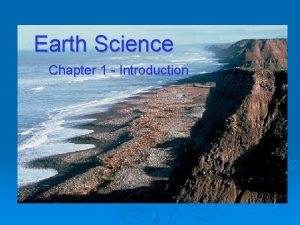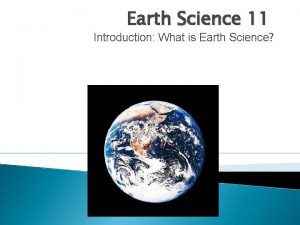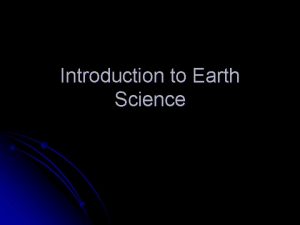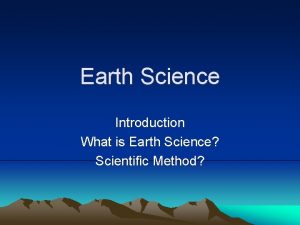Introduction to Earth Science Systems Solid Earth 1

































































- Slides: 65

Introduction to Earth Science Systems - Solid Earth - 1. Rotation, shape, gravity 2. Structure and composition 3. Dynamics 4. Formation 5. Beyond the Earth Frédéric Deschamps, Institute of Earth Science, room 501, frederic@earth. sinica. edu. tw

Power. Point files Download on http: //www. earth. sinica. edu. tw/content/people/frederic/ Bibliography l William Lowrie : Fundamentals of geophysics l F. Stacey & P. Davis : Physics of the Earth l l Geoffrey Davies : Dynamic Earth D. Turcotte & G. Schubert : Geodynamics

Introduction to Earth Science Systems 1. Shape, gravity, rotation - The shape and size of the Earth - Gravitation - Gravity and the Figure of the Earth - Gravity anomalies and the Earth’s interior - The rotation of the Earth

The Earth is a sphere (to the first approximation)

Earth’s size and shape l Some hints for a convex surface : - Sun’s rays illuminating mountain peaks and sky after sunset - Ships disappearing slowly over the horizons. - Earth’s Shadow during partial eclipse of the Moon Greek mythology : Earth (land + Mediterranean sea) has a disk shape , and is surrounded by a circular stream (Oceanus) l Anaximander (610 -546 BC) : Heavens is a sphere surrounding a flat Earth at its center l Pythagoras (582 -507 BC), further proposed by Aristotle (384 -322 BC): Earth is a sphere l

Erathostenes and the radius of the Earth l Erathostenes (275 -185 BC) : - At summer solstice, the Sun’s ray at noon shine vertically at Syene (Aswan), … but make an angle of 7. 2º at Alexandria - This angle ( ) is also the difference of latitude between Alexandria and Syene. - Knowing the distance (d) between the two cities, one can get the Earth’s circumference (L) and radius (R) : - Application : d = 5000 stadium, thus L = 250000 stadia. With 1 stadium = 185 m, L = 46250 km. Modern values : L = 40030 km, R = 6371 km

Measure of a meridian arc In 1671, Jean Picard measured an arc of meridian using triangulation survey methods l - Triggered by progress in optics and invention of the telescope allowed doing accurate measurements of angles. - Distance AB is split in small segments AA’, A’D’, … - Angles ADA’ and A’CA and distance DC allows calculating distance AA’ l He deduced the radius of the Earth : R = 6372 km

Newton and the oblate ellipsoid Newton : the shape of a rotating Earth is an oblate ellipsoid, flattened at the pole and bulged at the equator. l - At equator, the centrifugal acceleration opposes the gravity acceleration, and the pressure at the bottom of the column is reduced. - Reduced central pressure cannot sustain water column along polar radius, and this column is shorter. l Consequences : - Gravity acceleration is smaller at the equator than at the pole because 1) rocks are on average further away from the Earth’s center and 2) centrifugal acceleration reduces gravity acceleration. Confirmed by Richer experiments. - An arc of meridian close to the pole is longer than a arc of meridian close to the equator. Expeditions where sent in Finland (1736 -1737) and in Peru (17351743) to check this. Results confirmed Newton’s hypothesis

Richer : latitudinal variations in g Jean Richer (1672) : a pendulum at Cayenne (close to the equator) oscillates slightly slower than in Paris by about 2 minutes per day : its period P is larger at Cayenne. l The pendulum length is unchanged, therefore g must be slightly smaller at the equator than at higher latitudes

Gravitation

Gravity force, acceleration, and potential The gravitational force between two objects is proportional to the product of their masses and inversely proportional to the square of the distance between them : l G = 6. 672× 10 -11 Nm 2/kg 2 is the universal Gravitational Constant : l Gravitational acceleration : l The gravitational force is a central force, and derives from a potential UG :

Kepler’s third law The period of time it takes for a planet to complete an orbit, squared, is proportional to the mean distance between the planet and the Sun, cubed : T 2 R 3 T 2 = k R 3 k = constante = 4 2/GMS The 3 rd law derives from the conservation of the momentum (i. e. , Newton’s 2 nd law of motion) l l It can be applied to the Earth/moon system, and any other gravitational system

Gravity acceleration at the surface of the Earth Newton applied the third law of Kepler to determine the gravity acceleration g. G at the surface of the Earth. For the Earth/Moon system, the 3 rd law of Kepler writes : l where r. L is the Earth/Moon distance, and T the orbital period of the Moon b. Z b. G M m r. L The orbital period of the Moon is well known, T = 27. 3 days, and it is also known that r. L/R ≈ 60. With R = 5500 km, Newton determined g. G = 8. 48 m/s 2. l A better estimate of Earth‘s radius is R = 6372 km (from Picard in 1671), leading to g. G = 9. 8 m/s 2.

Determination of the universal gravity constant Knowing the value og G is essential for applications of the law of gravity and third law of Kepler, in particular the determination of planetary masses l - Cavendish 1797: Two metal spheres on a 1. 8 m wooden rod suspended by wire. Bring two 350 lb spheres close: wire twists. - Today (U. Washington): Torsion Pendulum: gold-coated Pyrex rectangle hung from an almost invisible torsion fiber and surrounded by mirrors for a laser system that monitors twisting. l Modern value : G = 6. 674215 10 -11 Nm 2 kg-1 14

Mass of the Earth Knowing the gravity constant, the mass of the Earth can be directly determined from its radius and the third law of Kepler : l T = 27. 3 days G = 6. 674215 10 -11 Nm 2 kg-1 R =6371 km r. L/R = 60 M = 6. 0× 1024 kg

Gravity and the figure of the Earth

Figure of the Earth: the ellipsoid As a consequence of its rotation, the Earth is not exactly a sphere, but an ellipsoid … l l There is an equatorial bulge: R - c ~14. 2 km - The equatorial radius is slightly larger (a=6378 km) than the average radius (R=6371 km) … - … and the polar radius is slightly smaller (c=6357 km) than the average radius. l Flattening: f = (a – c)/a a - R ~7. 1 km c R a f ~ 1/298. 257 Note: Flatening for an hydrostatic sphere in rotation (Newton): f = 1/299. 5. The Earth’s interior is not perfectly hydrostatic, maybe due to internal density contrast.

Geographic & geocentric latitudes The geocentric latitude l’ of a point on the Earth is defined by the angle between the radius (joining this point to the center of the Earth) and the equator. l The geographic latitude l is defined by the angle between the vertical at this point and the equator l w b. Z b. G q l' g l In the case of an ellipsoid, the directions of the vertical and of the radius are different. l The geographic and geocentric latitudes are different : (l – l’) is zero at the equator and at the poles, and reaches a maximum of 0. 19º at 45º latitude. g = b. G + b Z

Gravity field l Gravity field derives from a potential. For symmetric, non-rotating planet: And the gravity acceleration is : Gravitational acceleration is directed inwards Axisymetric terms give access to the moment of inertia (A, B, C), hence to constraints on the radial mass distribution. l Lateral variations relative to this gives information on lithosphere thickness, dynamic processes, lateral variations in interior. l

Moment of inertia: definition The moment of inertia describe the mass repartition about a reference axis. For instance, about Oz (radius, Ri = xi 2 + yi 2): l I = mi (xi 2 + yi 2 ) = ∫ (x 2 + y 2 ) dm = ∫ (x 2 + y 2 ) d. V Moment I about the axis (OP) joining the center of mass, and the observation point : l where l, m, and n are the angles between the direction OP and the x, y, and z axis, and A, B, and C are the main moments of inertia: C = mi (xi 2 + yi 2 ) A = mi (yi 2 + zi 2 ) B = mi (zi 2 + xi 2 )

Moment of inertia: axisymetric ellipsoid l where q is the colatitude Axisymetic ellipsoid (A = B): Gravitational potential (Mc. Cullagh‘s equation), and acceleartion of gravity for an ellipsoidal Earth : l l Dynamical ellipticity: H = (C – A)/C for the Earth: H = 1/305. 456

Mac. Cullagh formula l Potential to the second order: - Non-dimensional moment of inertia: - Degree 2 Legendre Polynomial: l Mac. Cullagh formula: Potential for a sphere Flattening (2 nd order) Still need to add the centrifugal acceleration due to rotation …

Centrifugal potential A fluid planet adopts the shape of the effective gravitational potential in the rotating frame of reference, or “reference ellipsoid”. l This includes gravitational and centrifugal terms. l w gc The centrifugal potential: g. G q l' l g l The centrifugal acceleration: - Effective acceleration : g = g. G + gc - Centrifugal acceleration is directed outwards - Maximum at the equator and null at the poles l The ratio of centrifugal to gravitational terms: - Earth : q = 1/288. 9 - Uniform planet: Mass concentrated towards center: g=g. G+gc

Angular momentum conservation The moment of inertia can be used to define the proper angular momentum, L = Iw (where w is the angular velocity). Because of the conservation of L, the moment of angular velocity increases (decreases) when the moment of inertia decreases (increases). l l Moment of inertia decreases if mass concentrate along the axis (or center of figure).

Moment of inertia and mass repartition l Moments of inertia for a homogeneous ellipsoid: I = mi (xi 2 + yi 2 ) = ∫ (x 2 + y 2 ) dm = ∫ (x 2 + y 2 ) d. V … about the axis of rotation … in the equatorial plane a and c are the polar and equatorial radius, and M is the mass of the ellipsoid l For a homogeneous sphere: a = c = R, and:

Moment of inertia and mass repartition l It is usual to define non-dimensional momentum of inertia: l For homogeneous sphere and ellipsoid :

Moment of inertia and mass repartition l An approximate expression as a function of flattening, f (derived from Mac. Cullogh formula, and the assumption that f<< 1): and where a & c are equatorial & polar radiuses, accelerations, and w the angular velocity the ratio of centrifugal and gravitational and l Some particular values: - All mass at center: C = 0 and J=0 - Uniform planet: - Hollow sphere: Planets & satellites are not hollow (see table on next slide).

Moment of inertia of planets

Equipotential An equipotential is a surface over which the gravitational potential remains constant. l For a homogeneous (no lateral variations of density), non-rotating sphere, equipotential are concentric spheres. l The potential on the equipotential of radius r is : U 0 U 1 R r r The equipotential Uo is the reference potential and is called the figure of the sphere l 2 1 U 2

Reference ellipsoid, Equipotential, & geoid For a homogeneous rotating planet, the reference ellipsoid is an equipotential (see Mac. Cullagh formula). l Due to additional shape perturbations (the non-rotating Earth is not perfectly spherical) and lateral variations in density, the true equipotential is not an ellipsoid. l l The true equipotential is called the geoid (or planetoid for other planets). Geoid anomalies are expressed relative to the reference ellipsoid, typically in the range 10 s meters. l Mass excess induce positive geoid anomalies reference ellipsoid). l In continents, the geoid follows the level that water would take in a channel cut through the land. l For example, where there is a hill, its mass pulls upwards on the water, raising the geoid. (equipotential is further away from the

Geoid’s deviations from an ellipsoid

Geoid

Gravity anomalies and the Earth interior

Geoid: influence of mass anomalies at depth A mass excess (deficit) induces a bump (depression) in the geoid, i. e. , the real equipotential is more (less) elevated than theoretical ellipsoid. l

Gravity anomalies from satellite tracking By tracking precisely satellites trajectory, one can recover geoid heights and gravity anomalies l GRACE: (Gravity Recovery And Climate Experiment) twin satellites launched in March 2002, to perform detailed measurements of Earth's gravity. l - Accuracy: 1 cm on geoid. - Lateral resolution: up to spherical harmonic degree 200 (~ 200 km).

GRACE gavity field anomalies (GGM 02)

Gravity anomalies gm : measured gravity; g. N reference gravity (e. g. , at reference ellipsoid). l Free air gravity anomaly Dg. F (correction for elevation to the reference ellipsoid, Dg. FA): l Topography Bouguer gravity anomaly Dg. B (correction for the rock layer between the station & ref. ellipsoid, Dg. BP): Free air gravity anomalies Bouguer gravity anomalies - At short wavelengths, Bouguer anomalies are cancelling (flat signal), but free-air anomalies are non-zero (rough signal). - At long wavelengths free-air anomalies are cancelling (smooth profile), but not Bouguer anomalies do not (bended signal). The mass of local topography is not compensated at depth, but the mass of regional topography is compensated.

Bouguer anomalies over oceans and continents

Gravity anomalies : oceanic ridges

Gravity anomalies : subduction zones

Isostasy : historical background Mountains constitute a mass excess at the surface, and should induce small gravity anomalies. l A plumb line close to big mountains should deviates towards the mountain l Measurments for Mt Everest and Himalaya : found a deviation of ~5. 23” … instead of the predicted 15. 89” l Some mass is missing

Isostatic compensation : models Airy model : crust has same density everywhere, and the Moho depth is lateraly varying. l hydrostatic equilibrium : pressure at depth C is the same everywhere continents : oceans : Pratt model : Juxtaposition of crustal blocks of different densities. The Moho is at constant depth. l continents : oceans : Vening Meinesz model : similar to Airy model, but take into account the flexure of the lithosphere. l

Over- and under-compensation D gl = 0 All systems are not in isostasy, due to dynamic effects. l Isostatic gravity anomaly (Dgl) : Dgl = Dg. B – Dg. R D gl < 0 Dg. R is correction for computed root l Imperfect isostatic compensation: - Crust does not react immediately to load changes. - “dynamic topography” caused by flow. D gl > 0 - Erosion induces overcompensation: real root is larger than computed root; hydrostatic equilibrium is reached through uplift. - Mountain building and tectonic thrusting induce undercompensation: real root is smaller than computed root; hydrostatic equilibrium is adjusted by subsidence.

Post-glacial rebounds : continents that have lost their thick ice sheet are experiencing slow uplift (Scandinavia, Canada). This is another example of hydrostatic adjustment l

The rotation of the Earth

Revolution without rotation The Earth-Moon system revolves about its center of mass S (located within the Earth). l During 1 month, the Earth center (E) describes a small circle around the center of mass. l If the Earth behaves as a rigid body, each point will also change position and move on small circles (e. g. , points 1 to 4 at surface). l Revolution without rotation causes each point in the Earth to describe a circlar path with same radius. l Each point experiences a centrifugal acceleration (due to rotation), with the same amplitude everywhere. l

Revolution without rotation The centrifugal acceleration of the Earth circular motion around the center of mass of the Earthmoon system is : l At the center, gravitational and centrifugal accelerations balances : l On the side facing the Moon, gravitational acceleration is larger than centrifugal acceleration : l On the opposite side, gravitational acceleration is smaller than centrifugal acceleration: l

Revolution without rotation : tidal acceleration On the near side, there is a residual acceleration g. T 1 pulling the surface towards the Moon : l directed towards the Moon On the far side, there is a residual acceleration g. T 2 pulling the surface away from the Moon : l directed away from the Moon

Residual tidal acceleration l Residual tidal acceleration: - On the far side of the Earth (A), the gravitational acceleration of the moon is smaller than the centrifugal acceleration. . . - … and on the near side of the Earth (B), it is larger than the centrifugal acceleration. - At D and D’, the residual acceleration nearly points towards the center of the Earth. Due to the inclination of the Earth’s rotation axis, tides amplitude depends on the latitude: l - At the equator, the two semi-diurnal tides are equal. - At intermediate latitudes, one of the tides is larger than the other. - At high latitude, there is only one diurnal tide.

Luni-solar tides The sun is also causing tides on Earth, but because it is much further away, the amplitude of solar tides is smaller by a factor ~2. 2. l Neap tides: Moon is in quadrature; solar and lunar tides are out of phase and partially compensate each other. l Spring tides: Moon is in opposition or conjunction; solar and lunar tides are in phase and add up constructively. l

Tidal torque & Earth breaking Because the Earth is not perfectly flexible (elastic), the tidal bulge is not colinear to the Earth-Moon direction. l The force on the near-side bulge is larger than that on the far-side: F 2 > F 1 l This induce a torque (a moment of force) that opposes the rotation of the Earth: the Earth is breaking ! l

Long-term variations of the length of the day Due to tidal friction, the rotation rate of the Earth is slowing down with time, i. e. the length of the day is increasing. l - Calculations gives a slowing rate of 2. 4 ms per century - Records of observation of eclipses by Babylonian allows estimating the deceleration rate : 2. 4 ms per century. - Observations of eclipses by the Arabs since the medieval times gives 1. 4 ms per century. - Observations with telescopes since the 17 th century (modern records) gives a similar estimates. - Difference may be related to non-tidal effects that oppose the deceleration of the Earth’s rotation.

Earth-Moon distance l Conservation of angular momentum : Where C and CL are the moments of inertia of the Earth and Moon, and d is the distance between the center of Earth and the center of mass of Earth/Moon system : d = r. L m/(m+M) l CLWL is negligible : The acceleration of gravity due to the Earth is balanced by the centrifugal acceleration of the moon l The moon gets further away (3. 7 cm/year) & its orbital period increases

Short term fluctuations of the length of the day There also exist short term fluctuations in the length of the day, which are not related to tidal braking: Short term (~ 1 month) variations, with amplitude of about 3 sec, are due to interaction between the solid Earth and its atmosphere. l Longer term (~ decades) variations are related to interactions (mechanical and/or electrical) between the liquid outer core and the mantle of the Earth. l

Chandler wobble At any moment, the axis of rotation of the Earth is displaced from the geometric axis of the ellipsoid by a few meter. This wandering is also called free nutation. - Due to the mass repartition about the axis of symmetry (polar and equatorial) of the ellipsoid. - The axis of rotation is wandering around an average position (that of the polar axis of the ellipsoid). - For a rigid, elastic body the period of nutation should be proportional to A/(CA) and equal to 305 days (Euler). - There actually two cycles (Chandler wobble), a seasonal cycle with amplitude ~0. 1 arc sec, and a 435 days cycle with amplitude ~0. 15 arc sec. Combination of the two leads to a 6 -7 years cycle. These effects are self-induced: free nutation.

Variations of the Earth orbital parameters Milankovich cycles, resulting from several effects (variations in eccentricity and precession of the Earth orbit, precession & change in the tilt of the Earth axis of rotation) , and explain the ice ages.

Precession of the Earth’s rotation axis The rotation axis of the Earth describes a circle about an axis perpendicular to the ecliptic. This movement is called precession, and its period is 25700 years (i. e. , the rotation axis moves by ~ 50. 4 arcsec per year). l Note: the period of precession (25700 years) is proportional to the dynamical ellipticity, H = (C-A)/C

Precession Effect is similar to that of a top. The attraction exerted on the bulge creates a torque perpendicular to the axis of rotation that modify the angular momentum, i. e. , the direction of the rotational axis.

Equinoxes and solstices Equinoxes : length of the day is equal to length of the night. The direction Sun. Earth is perpendicular to the plan perpendicular to the ecliptic and containing the rotation axis. l Solstices : day (night) is longest (shortest) in hemisphere and vice-versa. The direction Sun-Earth is within the plan perpendicular to the ecliptic and containing the rotation axis. l The intersection between the Earth’s orbit and Sun-Earth line at the spring equinox defines the vernal point (now pointing in the constellation of Aries). l

Precession of the equinoxes The combination of the precession of the ecliptic (109000 years) and of the axis of rotation of the Earth (25700 years) causes the vernal point to change position along the Earth orbit the with a period of leads to a 20’ 500 years cycle. l Equinoxes and solstices “drift” along the Earth orbit. l The Sun-Earth distance at a given season changes, which trigger climate changes. l

Precession and the aspect of the sky l The axis of rotation is points a direction in the sky that is varying in time … - Today it points towards Ursa Minor (Polaris) … - … but 2000 BC, it was pointing towards Thuban ( Draconis) … - … and 12000 years ago towards Vega ( Lyrae).

Changes in the tilt of the Earth’s axis of rotation The angle between the rotation axis and the pole to the ecliptic (the plan of the Earth’s orbit) is called obliquity. l l Today obliquity is equal to 23° 26’ … But it varies in time between 21° 55’ and 24° 18’ with a period of about 41000 years. l The obliquity controls the seasonal differences : larger obliquity increases the difference in temperature. l

Changes in the Earth’s orbital parameters Gravitational perturbation from other planets (mainly giant planets) induce l - a precession of the direction of ascending node with a period of 110000 years (a), - and changes in the eccentricity (from 0. 001 to 0. 06) of the Earth’s orbit with a period of 109000 years (b).

Precession of the Earth’s orbit The orbit of the Earth is also precessing with a period of about 109000 years

Milankovitch cycles Combined variations in the direction of the axis of rotation of the Earth induce climatic variations with periodicities of 20. 5, 41, 109, and 413 kyr … the Milankovitch cycles. l These variations are responsible for the succession of glacial and inter-glacial periods. l Today only precession in glacial mode, tilt and eccentricity are not. l
 My favorite subject
My favorite subject Chapter 1 introduction to earth science
Chapter 1 introduction to earth science Introduction to earth science
Introduction to earth science Science fusion introduction to science and technology
Science fusion introduction to science and technology Amorphous vs crystalline
Amorphous vs crystalline Example of solid solution are
Example of solid solution are Covalent molecular and covalent network
Covalent molecular and covalent network Example of crystalline solid
Example of crystalline solid Crystal solid and amorphous solid
Crystal solid and amorphous solid Crystalline solid and amorphous solid
Crystalline solid and amorphous solid Crystalline solid and amorphous solid
Crystalline solid and amorphous solid When a solid completely penetrates another solid
When a solid completely penetrates another solid Interpenetration of surfaces
Interpenetration of surfaces What is evaporation in mixtures
What is evaporation in mixtures Which layer of earth is most likely made of solid metals
Which layer of earth is most likely made of solid metals Is the earth's crust solid
Is the earth's crust solid Solid based rapid prototyping
Solid based rapid prototyping Aircrew escape systems are powered by a solid propellant
Aircrew escape systems are powered by a solid propellant Solid waste management introduction
Solid waste management introduction Solid waste disposal introduction
Solid waste disposal introduction Earth observing system data analytics
Earth observing system data analytics Big idea 7 earth systems and patterns answer key
Big idea 7 earth systems and patterns answer key Earth systems
Earth systems Big idea 7 earth systems and patterns
Big idea 7 earth systems and patterns Environmental science chapter 3
Environmental science chapter 3 Geosphere
Geosphere Earth systems 3209
Earth systems 3209 Earth systems foldable
Earth systems foldable Earth observing systems data analytics
Earth observing systems data analytics Hydrosphere
Hydrosphere Latitude of england
Latitude of england Decision support systems and intelligent systems
Decision support systems and intelligent systems Dicapine
Dicapine Embedded systems vs cyber physical systems
Embedded systems vs cyber physical systems Elegant systems
Elegant systems Where do polar and tropical air masses develop
Where do polar and tropical air masses develop Earth science sol 2010
Earth science sol 2010 Earth science practical review
Earth science practical review Earth science part d
Earth science part d Earth science lab practical
Earth science lab practical Earth science grade 9
Earth science grade 9 Dynamic equilibrium earth science
Dynamic equilibrium earth science Short note on hydrosphere
Short note on hydrosphere 4th grade science jeopardy
4th grade science jeopardy Geology earth science definition
Geology earth science definition Environmental science final exam study guide
Environmental science final exam study guide Earth science meaning
Earth science meaning Geology earth science definition
Geology earth science definition Earth science sol
Earth science sol Earth science vs geology
Earth science vs geology Earth science final exam
Earth science final exam Earth science lab practical
Earth science lab practical Earth science semester 2 final exam answers
Earth science semester 2 final exam answers Streak properties of minerals
Streak properties of minerals Vertical structure of the earth
Vertical structure of the earth Relative humidity reference table
Relative humidity reference table 4 major branches of science
4 major branches of science 282 ways to pass the earth science regents
282 ways to pass the earth science regents Earth science vs geology
Earth science vs geology Honors earth science
Honors earth science Why study earth science
Why study earth science Space scientific definition
Space scientific definition W.d. pattison
W.d. pattison Plate earth science
Plate earth science The sun warms the earth unevenly science or pseudoscience
The sun warms the earth unevenly science or pseudoscience Earth science review book
Earth science review book

